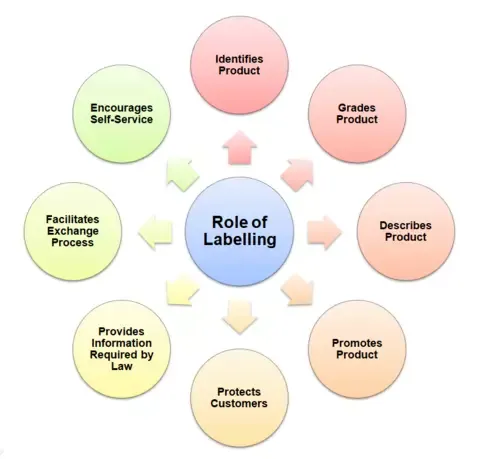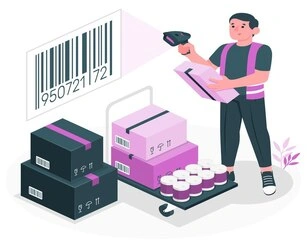Table of Contents:-
-
- Labelling Meaning
- Labelling Definition
- Purpose of Labelling
- Functions of Labelling
- Types of Labels
- Advantages of Labelling
- Disadvantages of Labelling
- Role of Labelling
Labelling Meaning
Labelling is the part of the product that carries information about the product and the seller. A label indicates the product’s brand name, the company logo, ingredients, promotional messages, and instructions for use. A label may be part of the package, or it may be the slip attached directly to the product.
A label is part of a product that carries information about the product and the manufacturer. A label is a part of the package, or it may be a tag attached outside the product.
There is a close relationship between labelling, packaging, and branding. The label is a small slip placed on or near anything (product) to denote its nature. contents, ownership, destination, etc. The function of standardisation is made perfect and known to the users through labels. A package is a place where labels can be affixed. It is a medium through which the manufacturer gives product-related information to the consumer.
A label plays an important role in making the packaging and branding functions meaningful. Hence, these three functions are closely related. The Packaged Commodities (Regulation) Order, 1975. makes it obligatory on the part of manufacturers to show details about the identity of the commodity, its weight, date of manufacture, etc. The provision of this enactment is done with the help of labelling.
Labelling Definition
According to, William J. Stanton “The label is that part of the product which carries verbal information about the product or the sellers (manufacturers or middlemen). A label may be part of the package or it may be a tag attached directly to the product.”
According to Mason and Rath, “The label is an information tag, wrapper or seal attached to a product’s package.”
Labels may range from simple tags attached to a product to complicated graphics that are part of the package. They perform several functions. At the very least, the label identifies the brand or product, such as the name Sunkist stamped on oranges. The label might also describe several things about the product – who made it, where it was made, when it was made, its ingredients, how it is to be used, and how to use it safely. Finally, the label might promote the product through attractive representations.
For example, coca-cola recently redrafted the graphics on its soft drink as a part of a broader effort to give the brand more meaning & social relevance to its youth audience. Its labelling has been affected in recent times by unit pricing, open dating & nutritional labelling.
Purpose of Labelling
A label goes on describing the product’s specialities, which makes the product a quick mover. The following are the purposes of labelling:
1) Brand Identification: Labelling helps in the identification and principal place of business of the person by or for whom the pre-packaged product was manufactured, processed, produced or packaged for resale.
2) Description: Labels provide information regarding the food product. It describes the nutritional values, contents, cost, product usage methods, shelf life etc.
3) Promotion: Finally, labels help in promoting the product through attractive and bright graphics replacing paper labels glued on cans and bottles.
4) Other Objectives
i) Information about the product or the characteristics of the product can be made known to the buyer through labelling. It describes the specialities of the product. This will make an item move fast. As far as the customers are concerned, it will fetch much importance.
ii) Labels will avoid confusion when several products are displayed in a shop. The label helps a buyer to get what he needs. It indicates the quality and standard of the products.
iii) Labelling makes a product be judged by the consumers, and at the same, it gives a guarantee of the product’s standard.
Functions of Labelling
1. It defines the product and, therefore, the identification of a product is easy.
2. It stresses the standard and other features of the product that are advertised.
3. It enables the manufacturer to give clear instructions to the customer about the proper use of the product.
4. By mentioning prices, undue price variations caused by the intermediaries are avoided. In other words, the price is recorded, registered, and maintained.
5. It encourages the production of standardized and quality products.
6. It provides a method for the manufacturer by which contact with the customer is established.
Types of Labels
Labels can be classified into three forms:
1) Brand Label
This is the label which gives the name of the brand of the product only. They are exclusively meant for popularising the brand name of the producer. Taj Mahal Tea and Dalda Vanaspati is examples of this type of label. This type of label is part of the package of the product. Such labels do not provide any information about the product. Manufacturers of consumer items prefer to use this type of labelling.
2) Grade Labels
When a manufacturer produces many types of a product, he uses the label describing the type of the product i.e., quality or grade of the product so that consumers and middlemen may identify the product type. This type of label emphasizes standards or grades; therefore, it is known as a grade label. Dust Tea, Leaf Tea, Tea Bags, Long Cloth, Prima Fan, Delux Fan, etc., are some examples of grade labels. This label does not provide any information about the product and the producer. It is used as an indirect method of product identification.
3) Descriptive Labels
The labels that are descriptive are considered descriptive labels. They are almost illustrative. They provide full information to consumers about the product and the producer. This type of label also gives all the necessary information such as the date of manufacturing, date of expiry, the quantity of the product, quality of the product, contents of the product, and necessary instructions for the use of the product. Such labels are mainly used in medicines and cosmetics.
4) Informative Labels
The main object of these labels is to provide the maximum possible information. These may contain the product’s characteristics and in addition the method of using it properly. In the case of medicines, detailed labels are attached which even specify the side effects of using them.
Advantages of Labelling
1. It is a social service to customers, who very often do not know anything about the product’s characteristic features.
2. It avoids price variations by publishing the price on the label.
3. It helps the advertising activity of the organization.
4. It helps the customers to assess the superiority of a product.
5. It is a guarantee for the standard of a product. Hence, it increases the prestige of the product and of the manufacturer.
6. False claims are prevented by using labels on the product.
Disadvantages of Labelling
1. For an illiterate population, this is of no use.
2. It increases the cost of the product because labelling involves an expenditure on the part of the manufacturer.
3. Labelling is effective only where standardisation is compulsory.
4. It enables the customer to assess and compare the advantages of products before they are used. This ultimately ends in discarding one product in favour of the other.
Role of Labelling
The role of labelling is as follows:
1) Identifies Product
The label helps to identify the product and brand. It popularises the product and its brand name. Information and characteristics of the product can be made known to the buyer through labelling. It describes the specialities of the product. This will make an article move quickly.
2) Grades Product
The label helps to express the grade of the product. For example, wheat can be expressed with the grades such as 1, 2, 3, and 4. The label becomes useful to grade any product according to its quality. Labels provide information regarding the food product. It describes the contents, nutritional values, and cost, product usage methods, shelf life etc.
3) Describes Product
The label gives an introduction to the product and describes and expresses its grade. Information and instructions about when, where, and who manufactured the product, how many ingredients have been used in it, how to use the product and how to keep the product safe, etc, are given on the label. This becomes helpful to the customers.
4) Promotes Product
The label helps to promote the product. Customers’ attention is drawn by attractive and fascinating graphs, figures or marks. This motivates the buyers to purchase the product. The label plays an important role in sales and distribution as it makes the customers make buying decisions.
5) Protects Customers
The label protects the customers. Maximum selling price, quantity, quality etc, are mentioned on the label so that the customers are protected from the possible malpractice of middlemen. Labelling helps in the identification of the person by or for whom the pre-packaged product was manufactured processed, produced or packaged for resale.
6) Provides Information Required by Law
Another important function performed by labelling is to provide statutory warnings required by law. To put ‘smoking is injurious to health’ on the package of cigarettes and ‘Chewing Tobacco is Injurious to Health’ on the packet of Pan Masala are examples of statutory warning? Similarly, in the case of hazardous or poisonous products, appropriate statutory warnings need to be put on the label.
7) Facilitates Exchange Process
As a good many competitive products are available in a given product range, the label helps in avoiding unwanted confusion. This is of special importance in the case of drugs and chemicals where even a spelling mistake proves fatal to the users.
8) Encourages Self-Service
A label is a strong sales tool that encourages self-service operations. If the customers are supplied with the necessary information about the contents of the package or the container as its contents, weight, use, price, taxes, instruction and so on, customers can select the package of their choice from shelf space. Therefore, labelling has a special role to play in self-selling units.

